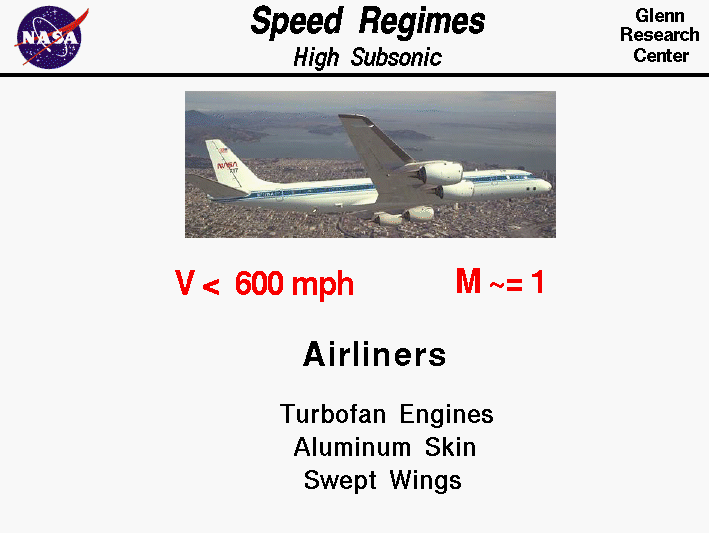
As an aircraft moves through the air, the air molecules near the
aircraft are disturbed and move around the aircraft.
Exactly how the air re-acts to the aircraft depends upon the
ratio of the speed of the aircraft to the
speed of sound through the air.
Because of the
importance of this speed ratio, aerodynamicists have designated it
with a special parameter called the
Mach number
in honor of Ernst Mach, a late 19th century physicist who studied gas
dynamics.
For aircraft speeds which are very near the speed of sound,
the aircraft is said to be transonic.
Typical speeds for transonic aircraft are greater than 250 mph
but less than 760 mph, and the
Mach number M is nearly equal to one, M ~= 1 .
While the aircraft itself may be traveling less than the speed of
sound, the air going around the aircraft exceeds the speed of sound
at some locations on the aircraft. In the regions where the
local airspeed is near or greater than the speed of sound,
we encounter
compressibility effects
and the
air density
may vary because of local
shock waves,
expansions, or
flow choking.
The first powered aircraft to explore this regime were the
high performance fighters of World War II.
These aircraft seemed to encounter a sound barrier at which
drag was increasing faster than thrust. There was speculation
in the mid-1940's that manned flight was not possible at speeds
faster than the speed of sound, even though the muzzle velocity of
rifle bullets is supersonic. Of course, the flight of the X-1A
in 1947 proved that people could fly faster than sound and, until
the recent retirement of the Concorde, any person with enough
money can fly supersonic. As mentioned above, even though
modern airliners typically fly at about M = .85, the
flow over the wings is transonic or supersonic.
Drag increases dramatically as an aircraft approaches Mach 1,
so airliners use high thrust
gas turbine
propulsion systems. On the
slide we show a DC-8 airliner which is powered by four
turbofan engines. The
wings
of airliners are typically
swept
in planform to reduce the transonic drag.
For Mach numbers less than 2.0, the frictional heating of
the airframe is low enough that
light weight aluminum is used for the structure.
Activities:
Guided Tours
Navigation ..

- Beginner's Guide Home Page
|
